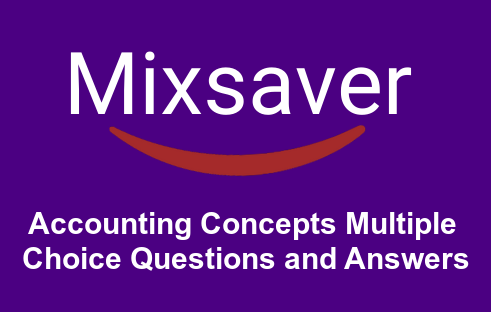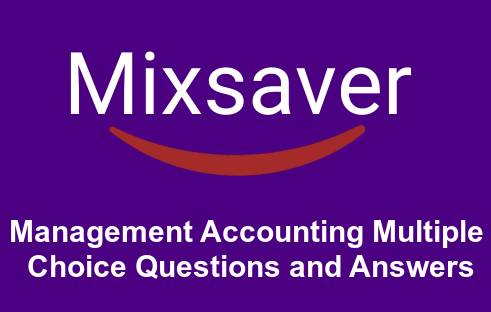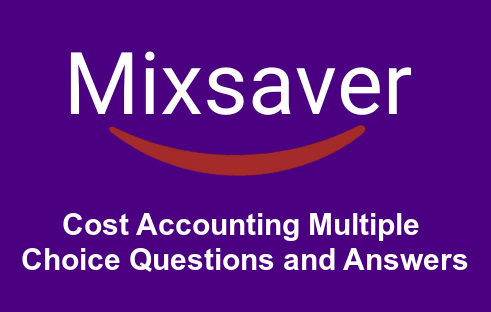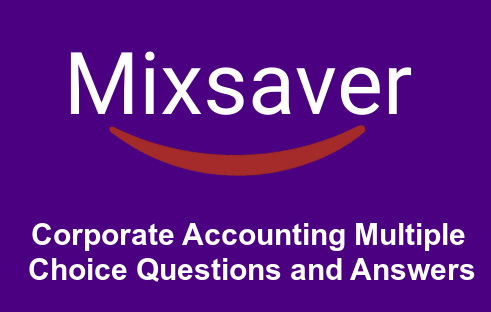Accounting Records of a Business Enterprise is Required by | MCQ on accounting concepts with answers pdf
1. The WDV of an asset after three years of depreciation on the reducing balance method e 15% per annum is rs. 49,130. What was its original value?
(a)rs. 40000
(b)rs. 80000
(c)rs. 45000
(d)rs. 70250
Ans. b
2. Which of the following statements is/are faise?
1. The term ‘depreciation’, ‘depletion’ and ‘amortisation convey the same meaning
2. The main purpose of charginig the profit and loss account with the amount of depreciation is to spread the cost of an asset over its useful life for the purpose of income determination.
(a) Only 1
(b) Only 2
(c) Both 1 and 2
(d) Neither 1 nor 2
Ans. c
3. Which of the following is not true with regard to fixed assets?
(a) They are acquired for using them in me conduct of business operations
(b) They are not meant for resale to earn proft
(c) They can easily be convertend into cash
(d) Depreciation at specified rates is to be charged on most of the foxed assets
Ans. c
4. Original cost = rs. 1,00,000, life =5 years, expected saivage value = rs.5,000, rate of depreciation per annum =?
(a) 20.0%
(b) 19 5%
(c) 19%
(d) 19 4%
Ans. c
5. A Ltd purchased a machine on 01.01.2003 for rs. 120,000. Installation expenses were rs. 30,000. Residual value after 5 years was rs.5.000. On 01.07.2003, expenses for repair were. incurred to the extent of rs. 2.000. Depreciation is provided @10% per annum under written down value method. Total depreciation after 2 years will be
(b)rs 13000
(a)rs. 25000
(c)rs. 10,500
(d) rs. 28500
Ans. d
6. Useful life of an asset can be described as
(a) the penod over which a depreciable aset is expected to be used by the enterprise
(b) the number of production or similar units expected to be obtained fromi the use of the asset by the enterprise
(c)10 years
(d) Both a and b
Ans. d
7. Which method of depreciation is effective if repairs and maintenance Cost of an asset increase as it grows old?
(a) Straight line trethod
(b) Sirking fund method
(c) Annuty method
(d) Reducing balance method
Ans. d
8. A machine was bought at a cost of rs. 5,00,000 on 1.1.2002. During its life of 10 years, it will be depreciated on SLM basis. On 31.12.2009, the machine was sold for 1,50,000 Find out the profit/loss.
(a) Loss of rs. 1.50,000
(b) Profit of rs. 50,000
(c) Profit of rs. 1,00,000
(d) Profit of rs. 1,50,000
Ans. b
9. Ram purchased a computer on 1.04.2010 for rs. Rs. 6,00,000 He is charging depreciation on written down value method. On 31.03.2011, he sold the computer for rs. 1,65,000 and incurred a loss of rs. 75,000. The rate of depreciation per annum is
(a) 10%
(b) 15%
(c) 60%
(d) 25%
Ans. c
10. Depletion method of depreciation is normally applied in case of…. assets.
(a) wasting
(b) intangible
(c) tangible
(d) current
Ans.
MCQ on Journal and Ledger pdf
11. Under annuity method, the amount of depreciation is
(a) fixed
(b) decreasing every year
(c) revalued every year
(d) increasing every year
Ans. a
12. If the rate of depreciation is same, then the amount of depreciation under straight line method vis-a-vis written down value method will be
(a) equal in all years
(b) equal in first year but lower in subsequent years
(c) equal in first year but higher in subsequent years
(d) lower in first year but equal in subsequent years
Ans. c
13. A mine was taken on lease for rs. 2,00,00,000. Its total production capacity is 4,00,000 metric tonnes. What will be the depreciation in 2007, if it produced 40,000 metric tonnes in 2007?
(a) rs. 10 lakhs
(b) rs. 20 lakhs
(c) rs. 50 lakhs
(d) None of these
Ans. b
14. A machinery is purchased for rs. 15,000 on 1st April 2005 and depreciation@ 10% per annum is provided. Calculate the amount of difference in depreciation as per SLM and WDV basis in the year 2006-07.
(a) rs. 150
(b) rs. 1,000
(c) Nil
(d) rs. 200
Ans. a
16. Amortisation refers to writing-off
(a) depleting assets
(b) wasting assets
(c) intangible assets
(d) fictitious assets
Ans. c
18. According to Income Tax Act, which method of providing depreciation should be followed?
(a) Reducing balance method
(b) Siniking fund method
(c) Annuity method
(d) Straight line method
Ans. a
19. Which of the following is depleted?
(a) Land
(b) Goodwill
(c) Machinery
(d) Quarries
Ans. d
20. Obsolescence means decline in the value due to
(a) fall in the market price
(b) new technology, innovations and inventions
(c) physical wear and tear
(d) efflux of time
Ans. b
Principles of Accounting MCQs with answers pdf
21. Which method of depreciation takes into account the element of interest on capital outlay?
(a) Depletion method
(b) Annuity method
(c) SLM method
(d) WDV method
Ans. b
22. The main objective of providing depreciation is to
(a) reduce tax burden
(b) provide funds for replacerment of fixed asset
(c) show true financial position in the balance sheet
(d) comply with legal requirements
Ans. b
23. Depreciation is the process of
(a) allocation of cost of asset to the period of its life
(b) verification of assets
(c) assets valuation
(d) decreasing the value of asset
Ans. a
24. Under annuity method, asset account is debited by
(a) interest account
(b) depreciation fund account
(c) sinking fund account
(d) None of the above
Ans. a
25. Annuity method is designed for which of the following?
(a) Leases
(b) Intangibles
(c) Fixed assets
(d) Any of these
Ans. a
26. A machine of rs. 3,000 was sold for rs. 4.200. Depreciation provision to date was rs. 400 and commission paid to selling agent was rs. 420 and wages paid to workers for removing the machine was rs. 30. Profit on sale of machine will be
(a) rs. 1,200
(b) rs. 1,000
(c) rs. 1,150
(d) None of these
Ans. c
27. Shyam of Chennai sends out 1,200 boxes of chocolates costing rs. 200 each. 1/10th of the boxes were lost in transit. 2/3of the boxes received by the consignee were sold. If the boxes were sold on cost plus 25%, then the amount ol sales value will be
(a) rs.1,04500
(b) rs. 190000
(c) rs. 1,11250
(d) rs. 180,000
Ans. d
28. Which of the following statement is wrong?
(a) Consignor is the owner of the consignment stock
(b) Del-credre commission is allowed by consignor to protect himself from bad debts
(C) Proportionate consignor’s expenses are added up witn consignment stock
(d) All proportionate consignee’s expenses will be added up tor valuation of consignment stock
Ans. d
29. Pof Delhi sends out 100 boxes of toothpaste costing rs. 200 each. Each box consists of 12 packets, 60 boxes were sold by consignee at rs. 20 per packet. Amount of sale value will be
(a) rs. 14,400
(b) rs. 12,000
(c) rs. 13.200
(d) rs. 14,200
Ans. a
30. Consignment account is prepared in the books of
(a) consignor
(b) consignee
(c) third party
(d) None of these
Ans. a
General Accounting Principles MCQ pdf
31. X sends out 400 bags to Y costing rs. 500 each. ConsignorS expenses were rs. 20,000, Ys non-selling expenses were rs. 8,000 and selling expenses were rs. 1000. 300 bags were sold by Y. Value of consignment stock will be
(a) rs.50,400
(b) rs. 57,000
(c) rs. 52,000
(d) rs. 54,000
Ans. b
32. The consignor sends .. along with the consigned goods to the consignee.
(a) account sales
(b) performa invoice
(c) Both (a) and (b)
(d) None of these
Ans. b
33. Goods costing rs. 1,00,000 invoice price rs. 1,20,000 were sent to consignee. Goods sold by consignee for rs. 96,000 at invoice price. Consignee is entitled to a commission of 4% on cost price of sales made and 8% additional commission on difference between invoice price and cost price of sales made. Amount of commission payable to the consignee will be
(a) rs. 4,480
(b) rs. 5,630
(c) rs. 5,600
(d) rs. 9,600
Ans. a
34. X of Kolkata sent out 500 boxes costing? 150 each with the instruction that sales are to be made at cost + 45%. X draws a bill on Y for an amount equivalent to 60% of sales value. The amount of bill will be
(a) rs. 64,000
(b) rs. 25,000
(c) rs. 65,250
(d) rs. 50,000
Ans. c
35. X sent goods to Y costing rs. 30,000 at cost plus 25%. These goods are to be sold at 10% above invoice price. Y sold a part of the goods at rs. 33,000. What will be the value of closing stock?
(a) rs. 8,000
(b) rs. 6,000
(c) rs. 7,000
(d) rs. 5,000
Ans. b
36. Account sales indicates
(a) the net amount due from consignor to consignee by way of commission
(b) the net amount due from consignee to consignor
(c) net sales affected by consignee
(d) None of the above
Ans. b
37. A sends 1000 units @ rs. 90 to be sold on consignment basis. Consignor’s expenses amounted to rs. 9000. 100 units were lost in transit. Find the new price per unit (loss is unavoidable).
(a) rs. 150 per unit
(b) rs. 610 per unit
(c) ra. 158 per unit
(d) rs. 110 per unit
Ans. d
38. A invoiced certain goods so as to show a profit of 33 1/3% on invoice price. 1/10th of the goods were lost in transit. The cost price of goods lost is rs. 40,000. The invoice value of goods sent out is
(a) rs. 5,00,000
(b) rs. 4,80,000
(c) rs. 4,50,000
(d) rs. 6,00,000
Ans. d
39. X sends goods to Y on consignment but 15% of the goods were lost in transit. Such loss will be borne by
(a) consignee
(b) consignor
(c) insurance company
(d) None of these
Ans. b
40. The stock lying unsold with the consignee belongs to
(a) consignor
(b) consignee, as he does not bear the risk
(c) Both a and b
(d) None of the above
Ans. a
Principles of accounting multiple choice questions and answers pdf | Accounting for Specific Business and Transactions MCQs
41. X sends out goods costing rs. 3,00,000 to Y at cost plus 25%. Consignor’s expenses were rs. 5,000. 1/10th of goods were lost in transit. Insurance claim of rs. 20,000 was received. The net loss on account of abnormal loss is
(a) rs. 12,500
(b) rs. 10,500
(c) rs. 30,500
(d) rs. 38,500
Ans. b
42. The abnormal loss on consignment is credited to
(a) consignment account
(b) profit and loss account
(c) consignee’s personal account
(d) All of the above
Ans. a
44. Over-riding commission is calculated on
(a) cash sales
(b) total sales
(c) credit sales
(d) credit salen less cash sales
Ans. b
45. X consigns 1,000 bags to Y costing rs. 400 each at an invoice price of rs. 500 each. Consignor’s expenses were rs. 14,000. Consignee’s expenses were-freight rs. 1,000 selling expenses rs 2,000. 900 bags were sold. The amount of stock reserve will be
(a) rs. 5,000
(b) rs. 12,000
(c) rs. 10,000
(d) rs. 10,200
Ans. c
46. Consignment account is a
(a) real account
(b) trading account
(c) nominal account
(d) personal account
Ans. c
47. If no del-credre commission is paid to the consignee… account will be debited for credit sale.
(a) consignment
(b) consignee’s
(c) consignor’s
(d) consignment debtor’s
Ans. d
48. Goods sent out on consignment rs. 2,00,000. Consignor’s expenses rs. 5,000, consignee’s expenses rs. 2,000, cash sales rs. 1,00,000, credit sales rs.1,10,000, consignment stock rs. 40,000, ordinary commission payable to consignee rs. 3,000, del-credre commission rs. 3000, the amount irrecoverable from customer rs. 2,000, What will be the profit on consignment?
(a) 38.000
(b) ? 37,000
(c) ? 36,000
(d) 43.000
Ans. b
49. X of Kolkata sends out 100 boxes to Y of Delhi costing rs. 200 each. Consignor’s expenses rs. 5000. Consignee’s expenses selling rs. 500. 3/5th of the goods were sold by consignee, 1/2 of the balance goods were lost in consignee’s godown due to fire. The value of abnormal loss will be
(a) rs. 5,000
(b) rs. 2,200
(c) rs. 4,000
(d) None of these
Ans. a
50. X sends out goods costing rs. 2,00,000 to Y. 3/5th of the goods were sold by consignee for rs. 1,40,000. Commission 2% on sales plus 15% of gross sales less all commission exceeds cost price. The amount of commission will be
(a) rs. 5,600
(b) rs. 5,800
(c) rs. 6,000
(d) rs. 5,043
Ans. d
51. When unsold stock is taken away by a co-venturer, then ……… account is debited.
(a) joint stock
(b) joint venture
(c) joint bank
(d) co-venturer’s capital
Ans. d
52. Memorandum joint venture account is prepared
(a) when each co-venturer keeps record of all the transactions himself
(b) when each co-venturer keeps records of their own joint venture transactions
(c) when separate set of books are maintained
(d) None of the above
Ans. b
53. Abought goods costing rs. 2,00,000. B sold 4/5th of goods for rs. 3,00,000. Balance goods were taken over by B at cost less 20%. Find out the profit on venture.
(a) rs. 1,70,000
(b) rs. 1,90,000
(c) rs. 1,32,000
(d) None of these
Ans. c
54. Joint venture accounting follows which concept?
(a) Accrual concept
(b) Cash basis concept
(c) Going concern concept
(d) Cost concept
Ans. b
55. Pari and Qutab enter into joint venture sharing profits and losses in the ratio of 1:1 Pari purchased goods costing rs. 2,00,000. Other expenses of Pari amounted to rs.10,000. Qutab sold the goods for rs. 1,80,000, Remaining goods were taken over by Qutab at rs. 20,000. The amount of final remittance to be paid by Qutab will be
(a) rs. 2,15,000
(b) rs. 2,05,000
(c) rs. 2,10,000
(d) None of these
Ans. b
56. A and B enter into joint venture sharing profits and losses in the ratio 3: 2. A will purchase goods and B will affect the sales. A purchased goods costing rs. 2,50,000. B sold them for rs. 4,00,000. The venture is terminated after three months. A is entitled to 10% interest on capital invested irrespective of utilisation period. The amount of interest received by A will be
(a) rs. 2,000
(b) rs. 10,000
(c) rs. 15,000
(d) rs. 25,000
Ans. d
57. A purchased 1,000 kgs of rice costing rs. 200 per kg. Other expenses were-carriage rs. 5,000, insurance rs. 5,000. 3/5th kgs of rice were sold by B at rs. 250 per kg. Remaining stock was taken over by B at 10% above cost. The amount of stock taken over will be
(a) rs. 90,000
(b) rs. 90,500
(c) rs. 92,400
(d) rs. 50,200
Ans. c
58. X spending a sum of rs. 10,000 on account of joint venture, will be credited to. … account in case of the records being maintained in the books of X.
(a) mermorandum JV
(b) cash
(c) joint venture
(d) co-venturer’s
Ans. b
59. Joint venture is a……. account.
(a) personal
(b) nominal
(c) real
(d) capital
Ans. b
60. When memorandum joint venture method is followed in the books of X, joint venture with YA/c will be credited with….for amount received by X.
(a) Y
(b) cash
(c) sales
(d) debtor
Ans. b
Accounting for Specific Business and Transactions MCQs
61. A and B enter into a joint venture sharing profits and losses equally. A bought rs. 5,000 kgs of rice @ 25 per kg. B bought 1,000 kgs of wheat@ rs. 32 per kg. A sold 1,000 kgs of wheat @ rs. 35 per kg and B sold 5,000 kgs of rice @ rs. 30 per kg. The profit on venture will be
(a) rs. 55,000
(b) rs. 50,000
(c) rs. 60,000
(d) rs. 28,000
Ans. d
62. M and N enter into a joint venture where M supplies goods worth rs. 600 and spends rs. 500 on expenses. N sells the entire lot for rs. 10,000 after meeting selling expenses amounting to rs. 500, Profit sharing ratio is equal. N remits to M the amount due. The amount of remittance will be
(a) rs. 6,900
(b) rs. 7,500
(c) rs. 5,300
(d) rs. 6,600
Ans. c
63. What is the nature of joint venture with co-venturer’s account?
(a) Nominal account
(b) Real account
(c) Personal account
(d) None of these
Ans. c
64. Following are the characteristics of joint venture except
(a) no common firm name
(b) contribution of funds
(c) sharing of profits/losses
(d) None of these
Ans. d
Accounting for Specific Business and Transactions MCQs
65. Which of the following methods of valuation of closinr stock is followed in joint venture accounting?
(a) Net realisable value
(b) Cost price
(c) Least of cost or net realisable value
(d) None of the above
Ans. d
66. If unsold goods costing rs. 20,000 are taken over by a co-venturer at rs. 15,000, the joint venture account will be credited by
(a) rs. 20,000
(b) rs. 15,000
(c) rs. 5,000
(d) Nil
Ans. b
67. A and B enter into a joint venture to underwrite the shares of K Ltd. KLtd makes an issue of 5,00,000 equity shares of rs.100 each. 80% of the issued shares are subscribed by the public. The profit sharing ratio between A and Bis 3:2. The balance unsubscribed shares are purchased by A and B in profit sharing ratio. How many shares are purchased by A?
(a) 60.000 shares
(b) 72,000 shares
(c) 40,000 shares
(d) 8,000 shares
Ans. a
68. When co-venturers initially contribute for a joint venture, which account should be debited, when separate set of books are maintained?
(a) Purchases account
(b) Joint bank account
(c) Venturer’s capital account
(d) Joint venture account
Ans. b
69. If separate of books are maintained and discount is received at the time of purchase of goods, then such a discount will be treated as
(a) credited to co-venturers’ account
(b) income of joint venture and hence credited to joint venture account
(c) will not be recorded in books of account
(d) expense of joint venture hence debited to joint venture account
Ans. b
70. Which of the following is incorrect?
(a) Joint venture can be formed with minor
(b) Joint venture is not based on going concern
(c) A bill of exchange is a negotiable instrument
(d) Noting charges are the expenses of drawee
Ans. a





